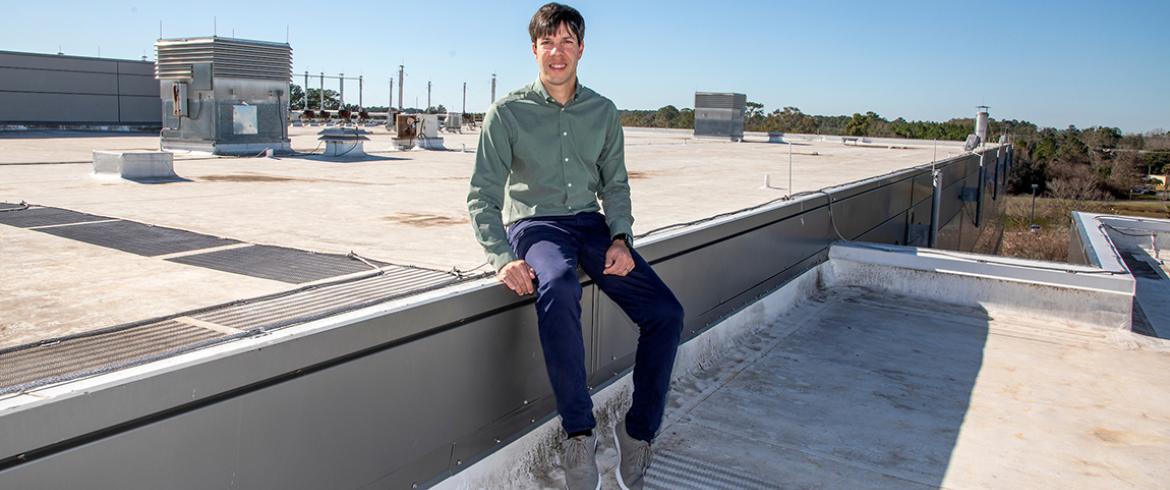
Pedro Fernández-Cabán, an assistant professor in civil and environmental engineering, is leading a team of FAMU-FSU College of Engineering researchers in finding solutions for mitigating wind damage on roofs, especially roofs on low-rise buildings.
Hurricane Ian struck Fort Myers Beach, Florida, in 2022, and the devastation reached well beyond the coast. Roof damage and flooding from the surge were two of the most common problems for people who battled the storm. Many were left burdened with time-consuming and costly repairs.
However, a new National Science Foundation (NSF) study may offer new options for better, stormproof resilient roofs in the future. Pedro Fernández-Cabán, an assistant professor in civil and environmental engineering, is leading a team of FAMU-FSU College of Engineering researchers in finding solutions for mitigating wind damage on roofs, especially roofs on low-rise buildings.
“Most of the wind-related damage inflicted by hurricane events is found on roof systems of low-rise construction,” Fernández-Cabán said. “Wind-induced roof failures can lead to wind and water intrusion into the building interior, further increasing monetary losses and compromising the well-being of its occupants. So that is where we are focusing our efforts.”
The project aims to find new innovative roof system geometries that can alleviate wind forces on buildings and prevent roof failures that can result in the loss of life and property during extreme wind events. The group is collecting data from wind tunnel experiments and leveraging AI tools to generate additional data for untested wind tunnel configurations.
“We are using machine learning models and computational fluid dynamics tools together with the information gained by wind tunnel experiments,” Fernández-Cabán explained.
The team attempts to improve the capabilities of machine learning and computational fluid dynamics (or CFD) for predicting extreme load effects on roof systems of low-rise buildings.
“Wind tunnels are often considered to be the most reliable testing tool for estimating wind forces, but not all possible wind conditions can be tested this way. So we are developing computational algorithms to fill the gaps,” Fernández-Cabán said. “By using several tools together, we can get a more complete picture of what the wind is doing.”
The group is leveraging a novel flow-control instrument at the Natural Hazards Engineering Research Infrastructure (NHERI) Experimental Facility at the University of Florida (UF) to conduct the research. The researchers hope to add valuable velocity and pressure data to the NHERI Data Depot when they publish their results.
The NHERI site at UF is one of eight NSF shared-use experimental facilities at colleges throughout the nation. These centers have specialized equipment to support innovative investigations for mitigating disasters caused by hazards and disasters like hurricanes. The NHERI network documents extreme events and their damage with imagery and data to help prevent similar destruction in the future.
"The successful completion of the project will have a broad impact on researchers, industry practitioners, and future scientists and engineers," says Fernández-Cabán. “We hope to offer potential design and retrofitting alternatives to improve the performance of roof systems under extreme wind conditions.”
The researchers plan to integrate machine learning and computational modeling to predict extreme wind loading. The data they collect will fill critical knowledge gaps that will enhance the performance of roof systems and make them more resilient. Home and business owners can directly benefit from the results of the project.
The research contributes to the National Windstorm Impact Reduction Program (NWIRP) established by Congress to improve the understanding of windstorms and their impacts and to develop and encourage the implementation of cost-effective mitigation measures to reduce those impacts.
The project, “ERI: Physical Simulation of Terrain-Induced and Large-Scale Turbulence Effects on the Effectiveness of Wind Mitigation Strategies for Low-Rise Buildings,” is funded through the Engineering Research Initiation Program of NSF.
RELATED ARTICLES
Engineering researchers receive $500,000 NSF grant to study hurricane hazards and evacuation
Remote Sensing Research Improves Hurricane Response
After the storm…FAMU-FSU Engineering researchers study long-term shelter needs of hurricane victims
